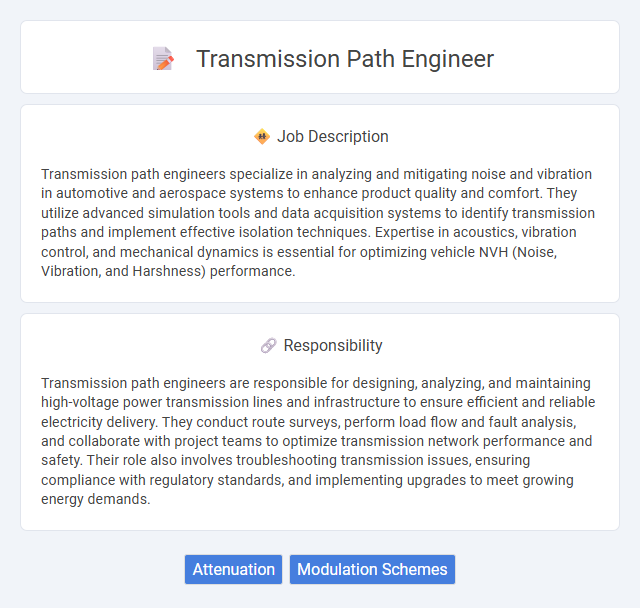
Transmission path engineers specialize in analyzing and mitigating noise and vibration in automotive and aerospace systems to enhance product quality and comfort. They utilize advanced simulation tools and data acquisition systems to identify transmission paths and implement effective isolation techniques. Expertise in acoustics, vibration control, and mechanical dynamics is essential for optimizing vehicle NVH (Noise, Vibration, and Harshness) performance.
Individuals with strong technical skills and a keen interest in electrical systems are likely to excel as transmission path engineers. Those comfortable working outdoors and in variable weather conditions may find this role more suitable due to the nature of site inspections and maintenance tasks. People who prefer routine desk jobs might face challenges adapting to the dynamic and field-based aspects of the position.
Qualification
Transmission path engineers typically require a bachelor's degree in electrical engineering, telecommunications, or a related field, with strong knowledge in microwave, fiber optics, and RF systems. Proficiency in transmission testing, network protocols, and signal analysis tools is essential for designing and optimizing communication paths. Relevant certifications such as Cisco CCNA or equivalent and experience with transmission equipment like OTN, SDH, and DWDM enhance job qualifications.
Responsibility
Transmission path engineers are responsible for designing, analyzing, and maintaining high-voltage power transmission lines and infrastructure to ensure efficient and reliable electricity delivery. They conduct route surveys, perform load flow and fault analysis, and collaborate with project teams to optimize transmission network performance and safety. Their role also involves troubleshooting transmission issues, ensuring compliance with regulatory standards, and implementing upgrades to meet growing energy demands.
Benefit
Transmission Path Engineer roles likely offer competitive salaries reflecting the specialized skill set required to design and maintain efficient electrical transmission systems. Employees may benefit from opportunities to work on cutting-edge technology projects, enhancing their professional growth and expertise. The job probably provides job stability and the chance to contribute to critical infrastructure, supporting long-term career development.
Challenge
Transmission path engineers likely face complex challenges involving the design and maintenance of high-voltage power lines that ensure reliable electricity transmission. They may frequently encounter difficulties related to environmental factors, regulatory compliance, and the need to optimize routes for efficiency and safety. Problem-solving skills and adaptability are probably essential to navigate the technical and logistical obstacles inherent in this role.
Career Advancement
Transmission path engineers specialize in designing and optimizing electrical power transmission systems, playing a crucial role in grid reliability and efficiency. Career advancement opportunities include roles such as senior engineer, project manager, and technical consultant, often requiring expertise in smart grid technologies and regulatory compliance. Developing skills in advanced simulation software and acquiring professional engineering licenses can significantly accelerate progression within this field.
Key Terms
Attenuation
A Transmission Path Engineer specializes in designing and optimizing communication channels to minimize signal degradation, with a primary focus on attenuation factors such as distance, material absorption, and interference. By analyzing frequency-dependent losses and implementing advanced materials or amplification techniques, they enhance signal integrity across optical fibers, coaxial cables, and wireless links. Their expertise ensures robust data transmission in telecommunications, satellite systems, and broadband networks, reducing downtime and maintaining high-quality connectivity.
Modulation Schemes
Transmission path engineers specialize in optimizing modulation schemes to enhance signal quality and data throughput in communication networks. They analyze and implement advanced techniques such as Quadrature Amplitude Modulation (QAM), Phase Shift Keying (PSK), and Orthogonal Frequency-Division Multiplexing (OFDM) to maximize spectral efficiency and minimize bit error rates. Expertise in adaptive modulation allows these engineers to dynamically adjust signal parameters based on channel conditions, ensuring robust and efficient transmission paths.
 kuljobs.com
kuljobs.com